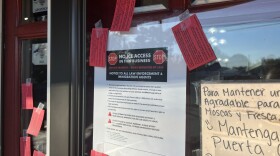Updated Friday, October 9 at 2:30 p.m.
The Durham County Sheriff's Office has doubled the amount of time inmates at the Durham County Jail are allowed to spend outside their cells. General population detainees, or mainly those awaiting trial, are allowed to spend eight hours a day outside their cells, an increase from four hours a day.
“Detainee conduct will determine the facility’s schedule as it relates to inmate movement. It will also continue to drive decisions regarding any future phases of the schedule," Sheriff Mike Andrews said in a statement. "Providing a secure environment while valuing the needs of those in the facility remains my primary focus.”
Original Post from Friday, July 10:
Ricky Alston spent 37 days in the Durham County jail. For most of his time, he was locked in his cell, a confinement that still causes him ripples of emotional distress.
“My friends now are like, ‘You’re different. Your eyes are changing and it looks like you’ve got some kind of demon inside of you.’ I definitely feel that sometimes,” Alston said.
Alston was a detainee during the “lock back,” a term used by protesters and detainees to describe the reduced amount of time inmates are allowed outside of their cells. In April, Sheriff Michael Andrews released a statement saying the Durham County Detention Facility was not in a “lock back” status, but was operating under a “modified detainee walk schedule.” At this time, a certain number of detainees were allowed only two hours outside of their cell at a time, every other day.
The Sheriff’s Office said it imposed the restriction because of a sharp increase in violence between detainees, and between detainees and detention officers. Guards also claimed to have found several improvised weapons.
Before the “lock back,” Alston said detainees were allowed outside their cells six to eight hours a day. He said a life of going from working in the kitchen and laundry room to his cell, then going back to work with a sliver of time outside in between was torture. Alston said detainees were allowed to do certain activities like watch TV and play basketball during a short amount of time outside work and their cell.
“You don’t treat a human like that. A dog has more room to move around then you do when you’re in jail,” he said.
Since Alston was incarcerated, the time detainees are confined in their cells has been reduced. Brian Jones, Director of Planning and Development for the Sheriff’s Office, said the detention center saw a decrease in hostility and chose to let a larger number of detainees outside their cells for more than two hours every day. They recently increased it to four hours every day.
But for Alston, a legacy of trying to cope with his confinement still haunts him.
“It didn’t do nothing but make me worse,” he said. “I’m living with my mom and trying to hold my composure, but I’m more angry now than I ever was before I went to jail.”
"We do not want to confine anybody longer than we have to."
Alston said he struggled with suicidal thoughts before his time in jail, a struggle that was only accelerated after witnessing two people try to jump from the roof of the jail during the “lock back.”
Jones said the detention facility reports suicides to the State Bureau of Investigation and the state Jail Inspector, but there is no policy in place to report attempted suicides. He said the “modified detainee walk schedule” does not aim to harm anybody, and tries to protect both detention staff and inmates.
“We do not want to confine anybody longer than we have to. It’s imposing restrictions on inmates who may not be the cause of behavior issues, but it’s for their safety as well,” Jones said. “While the policy impacts all inmates, we are simply trying to create an environment that is safe for everyone in the jail.”
Nearly 10 percent of North Carolina’s prison population was in solitary confinement as of March 2014, according to a study from the UNC School of Law. Deborah Weissman supervised the study, and said their research echoed Alston’s sentiment equating solitary confinement to torture.
“Trying to imagine being locked in a room for 23 hours a day with sensory deprivation, one gets nervous just thinking about it,” Weissman said. “In our report, we heard stories about how prisoners will lock on to any sensory entity. For example, they’ll form a relationship with a fly, and when the fly leaves they respond by just weeping. It’s heartbreaking because we’re all human beings.”
North Carolina prisons are different from jails like the one in Durham County. All county jails in the state have individual policies to implement similar “lock backs,” said Jennifer Blue, Managing Attorney of the Safe and Humane Jails Project. This means jails are not required to report when they are in a similar “lock back” status. Blue said the policy for jails is an internal administrative decision if it is “reasonably related to a legitimate governmental objection,” such as maintaining the security of the facility, inmates and staff.
“The court of law says that security is paramount to any other right,” Blue said. “We have concerns for inmates being locked up for say 23 hours a day, but there is concern for inmates having access to weapons and assaulting staff, so it is two-fold. But unfortunately, there is no way to evaluate if the concerns of jail authorities are validated, and a judge isn’t going to tell a sheriff how to run their jail, so it’s a sticky situation.”

Blue added that a “lock back” policy cannot be a form of punishment by law, and Jones said the Durham Sheriff’s Office only sees it as a safety measure. He said it offers inmates more time outside than is required by state law, which states that inmates be let out of their cell for an hour, three days a week after being incarcerated for at least 14 days.
Jones added that the Sheriff’s Office is cognizant of inmates’ mental health needs as they maintain the facility’s safety. This month, the Durham County Criminal Justice Resource Center increased the number of hours a psychiatrist is available for inmates from eight to ten hours a week.
But Jones said rehabilitation can be a challenge for jails because people are not detained for a long time. Last year, Jones said the average stay for an inmate in the Durham County jail was 17 days. Nevertheless, the jail does offer programs like the Substance Abuse Treatment And Recidivism Reduction (STARR) initiative to help incarcerated men and women.
Even though the jail has reduced the “lock back” hours for detainees, Jones said it’s too early to “claim victory” for the facility.
“It’s hard to sit back and say whether a policy was effective because it’s still in place. There is always going to be issues of violence in a jail, and we will do our best to try and curb those because that’s what we do,” he said.
But Weissman said the legacy of solitary confinement poses a bigger problem for jails and its inmates.
“We have to improve our developmental health systems, while we think about why we lock up so many people in the first place. No one wants to talk about structural changes, but without talking about them you are just tinkering around the edges. “
As people like Alston continue to pick up the pieces after being let out, friends and family of inmates will carry on protesting outside the jail on Friday.









